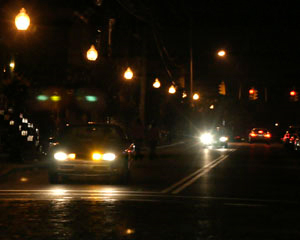 Researchers Develop Method to Reduce Headlamp Glare and Maintain Maximum Roadway Visibility
Researchers Develop Method to Reduce Headlamp Glare and Maintain Maximum Roadway Visibility
Within recent years, complaints of headlamp glare dramatically increased to the National Highway Traffic Safety Administration (NHTSA) after vehicles with new headlamp color, higher light output, and higher mounting heights took to American roadways. Scientists at Rensselaer Polytechnic Institute’s Lighting Research Center, through funding from NHTSA, have developed and demonstrated a method to reduce headlamp glare and maintain maximum visibility.
Evidence indicates that present-day low-beam vehicle headlamps do not provide sufficient visibility for driving speeds higher than 30 to 40 mph. However, few drivers use their high beams for fear of creating glare for oncoming motorists. Some vehicle lighting manufacturers have developed sensors that determine the distance and location of oncoming vehicles and adjust the headlamp’s brightness to reduce glare. However, this adjustment can also inhibit the driver’s visibility.
Scientists at the Lighting Research Center developed a method, called the Prime Beam, designed to work in conjunction with sensors to maximize visibility with high-beam headlights. It works by removing the precise angular region of the headlamp beam pattern that creates glare for oncoming drivers. As demonstrated in field tests, the method allows drivers to leave their high beams on to achieve maximum roadway visibility without the fear of causing glare for oncoming drivers.
This development culminates a two-year research project funded by NHTSA to examine the causes and effects of headlamp glare including the risks associated with glare to oncoming drivers, increased risks to drivers on two-lane highways, increased risks to drivers over the age of 50, and the overall effects of glare on driver performance.
According to John Bullough, Ph.D., head of the Lighting Research Center’s Transportation Lighting Program and co-principal investigator on the project, glare is a sensation caused by bright light in one’s field of view. Glare can reduce one’s ability to see, create feelings of discomfort or both.
“It’s difficult to directly link glare to crash risk because there are very few accident records attributing glare as the cause of the crash," says Bullough. "However, since glare reduces visibility, it is logical to use reduced visibility as a surrogate factor for crash risk, which we did. We also looked at drivers' behaviors such as head movements and speed variability as safety surrogates, which seem to occur more frequently when crash risk is higher. In our studies, these different surrogate measures all consistently indicated that glare increases crash risk.”
But glare can also be deceiving, warns Bullough. “ A driver’s visibility may be impaired by glare without the driver experiencing much discomfort. And some people, especially older drivers, may experience problems with visual re-adaptation—the ability of the eyes to recover their sensitivity to see objects after exposure to glare, even when the vehicle has already passed by.”
Bullough worked on the project with Lighting Research Center Director Mark Rea to further examine how headlamp mounting height, lamp aim, headlamp beam distribution, headlamp color, headlamp size, and cleanliness and condition of headlamps and windshields contributed to glare, crash risk and changes in driving performance.
They found that two-thirds of the several hundred vehicles tested in the study had at least one mis-aimed headlight, either aimed too low or too high. According to Bullough, a mis-aimed headlight influences visibility and glare more than several other factors including the type of bulb that’s used.
The Lighting Research Center's findings on vehicle headlights, visibility and glare were published by NHTSA in a series of four reports, the last of which was released in December 2008. All four reports are available on the NHTSA Web site (see listing below).
Bullough and Rea were invited in 2007 to summarize their first series of findings in a report submitted by NHTSA to Congress as part of the requirements of the Safe, Accountable, Flexible, Efficient Transportation Equity Act: A Legacy for Users (SAFETEA-LU). SAFETEA-LU legislation addresses the many challenges facing the nation’s transportation system and lays the groundwork for addressing future challenges. For more information about SAFETEA-LU, visit www.fhwa.dot.gov/safetealu/legis.htm.
Lighting Research Center reports published by NHTSA:
- Bullough, J. D., N. P. Skinner, R. P. Pysar, L. C. Radetsky, A. M. Smith and M. S. Rea. 2008. Nighttime Glare and Driving Performance: Research Findings
 , DOT HS 811 043 [report to the National Highway Traffic Safety Administration]. Washington, DC: National Highway Traffic Safety Administration.
, DOT HS 811 043 [report to the National Highway Traffic Safety Administration]. Washington, DC: National Highway Traffic Safety Administration. - Nighttime Glare and Driving Performance: Report to Congress. Click here.

- Bullough, J. D., N. P. Skinner, Y. Akashi and J. Van Derlofske. 2008. Investigation of Safety-Based Advanced Forward-Lighting Concepts to Reduce Glare
 , DOT HS 811 033 [report to the National Highway Traffic Safety Administration]. Washington, DC: National Highway Traffic Safety Administration.
, DOT HS 811 033 [report to the National Highway Traffic Safety Administration]. Washington, DC: National Highway Traffic Safety Administration. - Akashi, Y., F. Hu+ and J. D. Bullough. 2008. Sensitivity Analysis of Headlamp Parameters Affecting Visibility and Glare
 , DOT HS 811 055 [report to the National Highway Traffic Safety Administration]. Washington, DC: National Highway Traffic Safety Administration.
, DOT HS 811 055 [report to the National Highway Traffic Safety Administration]. Washington, DC: National Highway Traffic Safety Administration.
Publications
Sponsors
National Highway Traffic Safety Administration


